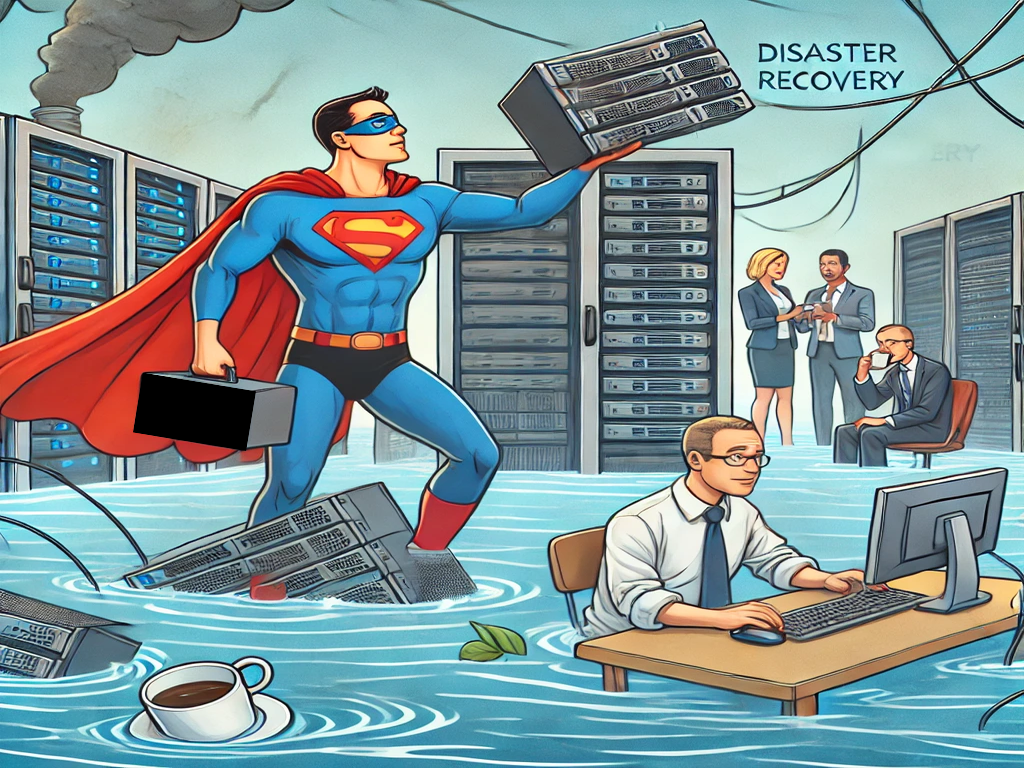
In today’s unpredictable IT landscape, having a robust disaster recovery plan is like having a spare tire—you hope you never need it, but when you do, you’ll be glad it’s there. For tech leaders managing mid-sized companies, ensuring business continuity isn’t just a best practice; it’s a necessity.
The Importance of Disaster Recovery Planning
Imagine this: It’s a typical Tuesday, and suddenly, your servers crash due to a cyberattack. Without a disaster recovery plan, this scenario could lead to significant data loss, operational downtime, and financial setbacks.
A well-crafted disaster recovery plan minimizes these risks, ensuring that your business can quickly bounce back from disruptions.
Steps to Create an Effective Disaster Recovery Plan
Begin by identifying potential threats to your IT infrastructure. This foundational step sets the tone for the entire disaster recovery plan by pinpointing vulnerabilities and prioritizing which risks demand the most immediate attention. Threats generally fall into three broad categories:
- Environmental Risks: Natural disasters like floods, hurricanes, earthquakes, or even prolonged power outages can cripple physical data centers or on-premises infrastructure. Understanding the geographic and environmental risks specific to your company’s locations is essential for creating tailored mitigation strategies.
- Technological Risks: This includes system failures, outdated software, hardware malfunctions, and, of course, cyberattacks. Many of these risks stem from unpatched systems, incompatible integrations, or dependency on single points of failure in your IT environment.
- Human-Induced Risks: These could be malicious, such as ransomware attacks, or accidental, like an employee unintentionally deleting critical files. Given that human error is often a significant factor in IT disruptions, incorporating this category into your risk assessment is vital.
How to Conduct a Thorough Risk Assessment:
- Audit Your Current Infrastructure: Review all components of your IT systems, from servers and network architecture to software applications. Identify areas with known vulnerabilities or dependencies.
- Use Risk Assessment Tools: Employ automated tools that scan for weaknesses in security, performance, or compliance. Many tools provide reports that categorize risks based on severity, allowing you to prioritize actions.
- Consult with Experts: If in-house expertise is limited, engaging third-party IT consultants can provide a fresh perspective on potential risks and offer tailored recommendations.
Assigning Risk Levels:
Document the findings from your assessment by assigning risk levels (e.g., low, medium, high) to each identified threat. Consider both the likelihood of occurrence and the potential impact on business operations. For example:
- High-Risk Example: A data center in a flood-prone area with no off-site backups.
- Low-Risk Example: A well-maintained application with a minimal history of issues.
Prioritizing Actions:
The purpose of risk assessment is not just to catalog potential threats but to prioritize efforts. For instance, if a high-risk assessment reveals that your core database lacks redundancy, immediate action would involve implementing a failover system or migrating critical workloads to a cloud provider.
Real-World Example:
A mid-sized healthcare company conducted a risk assessment and discovered that their backup systems were reliant on on-site storage. Recognizing the high risk of data loss due to localized events (like fires or equipment theft), they invested in a hybrid backup strategy combining cloud and off-site storage. When a power surge later caused hardware failures, the company quickly restored operations using their updated backup system, avoiding costly downtime and regulatory penalties.
A comprehensive risk assessment isn’t just about finding weak points; it’s about transforming vulnerabilities into action plans. By systematically identifying and prioritizing risks, IT leaders can create a disaster recovery plan that’s both proactive and resilient, ensuring that their organizations are ready for whatever comes their way.
Data Backup Strategies
Data is the lifeblood of modern businesses—lose it, and you might as well lose your wallet on Black Friday. Implementing a comprehensive backup strategy is your safety net, ensuring that critical information survives the unexpected. Let’s break down how to protect your data like the precious gem it is:
Regular Backups: Think of It as Brushing Your Teeth
Schedule frequent backups to capture the latest changes in your data. A nightly backup might suffice for some companies, but if you’re handling dynamic environments, hourly or even real-time backups could be your golden ticket. And let’s not forget automation—set it, automate it, and forget it. Trusting your team to remember daily manual backups is like trusting your cat to guard a fish tank.
Off-Site Storage: The “Just in Case” Strategy
Storing backups in a secure, off-site location is essential to protect against disasters like fires, floods, or the random coffee spill that takes out your on-premises server. Remember, off-site storage doesn’t have to mean physically carting hard drives across town like it’s 1999. Instead, partner with secure data centers that offer redundancy and compliance with industry regulations.
Example:
A mid-sized retail business opted for a hybrid approach, storing their weekly backups in a third-party data center 300 miles away. When a local power outage fried their servers, they restored operations within hours using off-site backups, saving their holiday sales rush.
Cloud Solutions: The MVP of Backups
For scalability and fast recovery, nothing beats cloud-based backup services. Providers like Microsoft Azure and Citrix offer robust options that grow with your needs. Cloud backups ensure data is always accessible, even if your office turns into a swimming pool during a storm.
And here’s the best part: with many cloud solutions, backups are encrypted both at rest and in transit, adding an extra layer of security. Just make sure to review data recovery times—after all, waiting hours to recover your backups is like ordering a pizza that shows up cold.
Consider integrating automated cloud backups into your disaster recovery plan. With features like scalability and multi-cloud support, tools like Citrix DaaS simplify business continuity and ensure your organization is ready to bounce back from disruptions.
Don’t Just Back It Up—Test It
A backup strategy is only as strong as its restoration process. You don’t want to discover your backups are corrupted on the day of a ransomware attack—trust me, that’s not the plot twist you want in your IT drama.
- Test Regularly: Conduct quarterly test recoveries to ensure data integrity and accessibility. This is your chance to verify that those backups are more than just fancy digital placeholders.
- Simulate Real-World Scenarios: Use disaster drills to evaluate how quickly and efficiently your team can restore data under pressure. Bonus: You get to uncover gaps and refine your strategy before it really counts.
- Document the Process: Keep a playbook for data restoration steps, including contacts for support. Your team will thank you when a crisis hits, and no one’s scrambling to Google “how to recover lost files.”
Think of backups like insurance: no one wants to deal with them, but when you need them, they’re the only thing between you and chaos. So go ahead, give your backups some love—because in the battle between IT disasters and your sanity, they’re your frontline defense.
Actionable Insights for Ensuring Business Continuity
Ensuring business continuity requires more than just drafting a disaster recovery plan—it’s about embedding preparedness into your organization’s DNA. Here’s how to make that happen:
Develop a Communication Plan
Clear communication can make or break your recovery efforts. Establish primary and secondary communication channels, such as email, messaging platforms, or dedicated hotlines, to keep all stakeholders informed during a disaster. Create pre-written templates for various scenarios to save time when speed matters most. Don’t forget to include external stakeholders like vendors and clients, who also need updates during disruptions.
Assign Roles and Responsibilities
Ambiguity leads to chaos in disaster recovery. Assign specific roles to your team members, such as a data recovery lead, communications officer, and IT infrastructure manager. Make sure each person knows their responsibilities, and document these roles in your recovery plan. Run drills to test their readiness and ensure everyone feels confident in their assigned duties.
Review and Update Regularly
Your IT environment isn’t static—neither should your disaster recovery plan be. Regularly review your plan to ensure it reflects changes in technology, personnel, or infrastructure. For instance, a new cloud migration or software update may require adjustments. Schedule quarterly reviews and involve cross-functional teams to keep the plan relevant and comprehensive.
As Benjamin Franklin aptly said, “By failing to prepare, you are preparing to fail.” A proactive, regularly updated disaster recovery plan is an investment in your company’s future, safeguarding against both headaches and costly financial repercussions. A little effort today can mean the difference between recovery and ruin tomorrow.
Key Takeaways
- A clear communication plan ensures all stakeholders are informed promptly during a disaster.
- Assigning roles and responsibilities minimizes confusion during recovery efforts.
- Regularly review and update your disaster recovery plan to keep it relevant and effective.
- Comprehensive data backup strategies, including cloud solutions, safeguard critical information.
- Disaster recovery planning is essential for minimizing downtime, maintaining operations, and protecting your business from financial losses.
